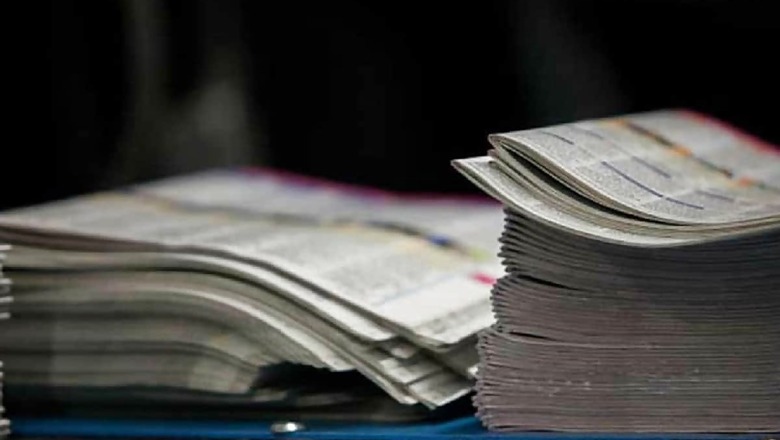
views
Cost of paper used to publish newspapers and magazines has jumped 20 per cent in the past three months due to demand-supply imbalance following the pandemic, prompting news publishers to rush to the government seeking waiver of 5 per cent import duty to help cut cost. An industry that was facing headwinds from a slowing economy even before the pandemic, was hit hard when most readers stopped buying newspapers and magazines on fears of them being carriers of viruses.
While there are no medical studies that have established the virus transmission theories, sales did not pick up even after lockdown restrictions were relaxed, industry leaders said. Now, the rising cost of newsprint created due to a drastic fall in supplies after 3 million tonnes of manufacturing capacities were either closed or converted to brown paper grades worldwide has dealt a second blow that is threatening the survival of the industry.
Indian Newspaper Society (INS) President L Adimoolam said most newspapers have stopped sending the hard copies to the rural areas with readership of less than 50 copies, to reduce the distribution cost. In a representation to Finance Minister Nirmala Sitharaman, INS has suggested cutting customs on import of newsprints.
They also want a fiscal stimulus package for the industry or raising tariffs of government advertisements by 50 per cent. "If working out a stimulus package for print media is difficult at this juncture, DAVP (Directorate of Advertising and Visual Publicity) may please consider releasing advertisement for all its departments to all publications with an increased tariff of 50 per cent, which would be highly helpful for the industry as a whole," the INS representation said.
It has also sought extension of the validity of RNI (Registrar of Newspapers for India) Circulation Certificates up to March 31, 2022, which will enable DAVP rates to remain the same till next year. It is estimated that the print media would take two-three years to recover from the current situation, the INS added.
Adimoolam told PTI, "The government helped a few industries (during the pandemic) with stimulus packages. We are (also) expecting some stimulus." Several newspapers have responded to the situation by cutting costs that included shutting down editions, reducing the number of pages and laying off staff. Several small papers have also closed down, Adimoolam added.
He said the newspaper distribution has become very costly. The Indian publishers continue to be dependent on imported newsprint due to insufficient domestic capacity/output and poor quality.
"Prices of newsprint have shot up by 20 per cent in the past three months. Another increase of 10-15 per cent is on the anvil next month which will severely impact the publishers," said the INS in the memorandum. Domestic producers are severely under-stocked on their raw materials to supply adequate quantities, it added. Moreover, leading domestic newsprint producers such as Emami Paper Mill, Khanna Paper and Shree Rama Newsprint have already increased their prices by Rs 3,000 to Rs 4,000 per tonne.
Requesting to remove 5 per cent customs duty, the INS said the tax would yield Rs 200 crore to the government exchequer in the next fiscal. "But, in view of the grim situation, it would be a great relief for the print industry." However, the Indian Newsprint Manufacturers Association (INMA), which represents the newsprint industry, has said enough capacity is available and the domestic industry is having full potential to provide unstinted support to print media. "Domestic industry has full potential to meet the demand in terms of quantity and quality. During COVID-19 lockdown, it is only domestic industry that came forward to support consumers," said INMA Secretary-General Vijay Kumar.
The domestic newsprint industry is facing the issue of under-utilisation of the installed capacity as more than 75 per cent market share of the newsprint has been captured by cheap imports and dumping in India by the foreign companies. When asked about the reason for such a situation, Kumar said import duty exemption was availed by "spreading a false narrative about domestic produce".
"Encouraging unethical import trade including stock and trade business dissuading domestic produce for want of cheap imports a demand supply gap was created. Such exemption and unethical imports denied a level-playing field to the domestic industry," he added. INMA has also filed an anti-dumping plea and an investigation was initiated by the Directorate General of Trade Remedies (DGTR) on January 20, 2020, and final measures are awaited.
"We understand that DGTR has sought a 5-month extension for completing their study on the anti-dumping case on newsprint. We request this extension of time be allowed to DGTR," said INS. It added that it is hopeful that the DGTR report will establish that newsprint of 42 gsm (grams per sq metre) and below to be exempted from anti-dumping as the same is not made in India.
Even the quality of other grades of newsprint is poor as compared to the imported newsprint, it added. As per the information available on the website of the INMA, the current domestic capacity of the newsprint industry is 2.2 million tonnes per annum (MTPA) and over 1.5 million tonnes is under-utilised due to continuous offloading of cheap imports.
Adimoolam however countered this saying, "It's not true. Almost 100 per cent newsprints produced by the Indian manufactures are being consumed. Only the balance is imported." The Indian newsprint industry produces newsprints below 45 gsm and the most of the newspapers in India now use 40 gsm and 42.5 gsm, Adimoolam said. "Instead of 40 gsm, you would have to use 45 gsm (indian newsprints) and it creates a 12 per cent difference in the cost," he said.
Also, the newspaper industry uses high-speed machines for printing and the domestic newsprint has issues with that, Adimoolam said. The Indian newspaper industry required 2.5 MTPA and the domestic production is around 1 MTPA and the balance 1.5 MTPA is being imported by the publications, Adimoolam added.
.
Read all the Latest News, Breaking News and Coronavirus News here




















Comments
0 comment